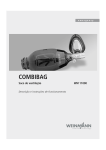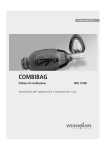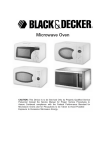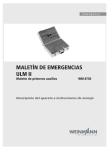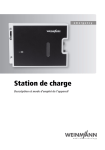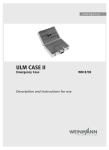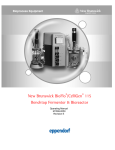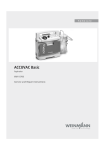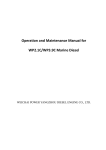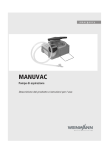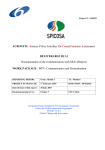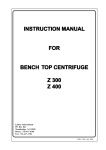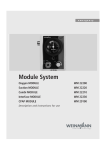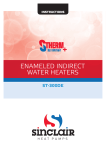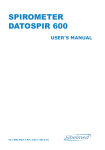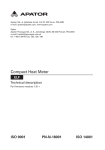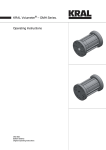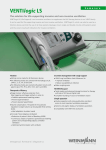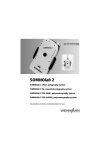Download Instructions for use COMBIBAG
Transcript
COMBIBAG Resuscitator Description and Operating Instructions WM 11000 Overview COMBIBAG Patient valve Safety valve Squeeze bag (compressable unit) Intake valve Accessories PEEP valve 2 Oxygen reservoir DEMAND valve Contents 1. Basic principle . . . . . . . . . . . . . . . . . . . . . . . . . . 1.1 Purpose . . . . . . . . . . . . . . . . . . . . . . . . . . 1.2 Function . . . . . . . . . . . . . . . . . . . . . . . . . . 1.3 Special Features of the COMBIBAG . . . . . . . 4 4 4 5 2. Description of the resuscitator . . . . . . . . . . . . . . . 7 2.1 COMBIBAG components . . . . . . . . . . . . . . 7 3. Safety instructions . . . . . . . . . . . . . . . . . . . . . . . . 9 4. Operating instructions . . . . . . . . . . . . . . . . . . . . 4.1 Introductory remarks . . . . . . . . . . . . . . . . . 4.2 Checking the function . . . . . . . . . . . . . . . . 4.3 Guide values for ventilation . . . . . . . . . . . . 4.4 Mask ventilation. . . . . . . . . . . . . . . . . . . . 4.5 Ventilation via an endotracheal tube . . . . . . 4.6 Increasing the oxygen concentration . . . . . . 4.7 PEEP ventilation . . . . . . . . . . . . . . . . . . . . 4.8 Volume measurement . . . . . . . . . . . . . . . . 4.9 Use of HME-Filters . . . . . . . . . . . . . . . . . . 10 10 10 11 12 12 13 14 14 14 5. Hygienic preparation . . . . . . . . . . . . . . . . . . . . 15 5.1 Cleaning during use . . . . . . . . . . . . . . . . . 16 5.2 Maintenance and service . . . . . . . . . . . . . 16 6. Spare parts . . . . . . . . . . . . . . . . . . . . . . . . . . . 6.1 Standard scope of supply . . . . . . . . . . . . . 6.2 Accessories . . . . . . . . . . . . . . . . . . . . . . . 6.3 Spare parts . . . . . . . . . . . . . . . . . . . . . . . 17 17 18 19 7. Technical and performance data . . . . . . . . . . . . 22 8. Warranty . . . . . . . . . . . . . . . . . . . . . . . . . . . . . 24 9. Declaration of conformity . . . . . . . . . . . . . . . . . 25 3 1. Basic principle 1.1 Purpose The COMBIBAG is for the manual ventilation of children (from a body weight of 10 kg) and adults via a face mask or endotracheal tube. The respiratory air can be enriched with oxygen. 1.2 Function On squeezing the bag, a volume of gas (air, air enriched with oxygen or pure oxygen) is forced through the resuscitation valve into the patient’s lungs. As soon as the elastic bag is released, it fills up again via the inlet valve, resuming its former shape. At the same time, the diaphragm in the patient valve closes the connection to the bag and opens the expiration passage. The patient then exhales into the atmosphere and expired air cannot flow back into the bag. In case of spontaneous breathing, the patient can breathe independantly in and out via the expiration passage. Exspiration Intake valve Inspiration Squeeze bag •••••• •••••• Bag filling up Patient valve (non-rebreathing valve) 4 Basic principle Compression 1.3 Special Features of the COMBIBAG COMBIBAG, the first manual resuscitator with segmental division for adults and children. •••• Hitherto, at least 2 resuscitation bags were required to ventilate patients of all age groups, a child resuscitation bag and a large adult resuscitation bag. Now the special design featuring the COMBIBAG covers both functions. The bag is divided into two segments (one large and one small) by two longitudinal troughs, marked with appropriate symbols. The tidal volume required can be obtained by squeezing the adult or child segment: • up to 500 ml in child ventilation • 500 - 1200 ml in adult ventilation. •••• The usual, separate child bag becomes unnecessary. The principle of “two bags in one” is extremely economical and saves space in each emergency kit. COMBIBAG, the first manual resuscitator with a 2-stage safety valve. By now, pressure relief as a function of the variable risks present in ventilation via face mask or endotracheal tube remained unsolved. The majority of manual resuscitators only have a pressure limit at 50 - 60 mbar (50 - 60 cm H2O), a reasonable limit adapted to healthy lung conditions. With use of manual resuscitators and face mask ventilation in inexperienced hands, however, there is always the risk that anxiety of the administrator and the eager trial to produce very effective ventilation may lead to an inflation of the stomach at pressures above Basic principle 5 20 mbar resulting in regurgitation with following apiration. Moreover, there is the risk with ventilation of children independant from face mask or endotracheal tube that high ventilation pressures may hurt the lungs. With the COMBIBAG 2-stage safety valve it is now possible to set a pressure limit: • of 20 mbar (20 cm H2O) for mask resuscitation child ventilation and • one of 60 mbar (60 cm H2O) for resuscitation via an endotracheal tube with adults. Hazards in ventilating non intubated patients diaphragm trachea •7•U•D•F•K•H•D stomach lungs contens of the stomach esophagus pressure > 20cm H2O 6 Basic principle pressure < 20cm H2O effect 2. Description of the resuscitator 2.1 COMBIBAG components The COMBIBAG resuscitator for adults and children consists of 4 working parts: Patient valve (non-rebreathing walve) Safety valve Squeeze bag (compressable unit) Intake valve Patient valve The patient valve consists of: • the valve body with bag adapter, • inspiration cone for connection of the mask or endotracheal tube connector(diameter 22/15 mm) • valve diaphragm for separating inspiration and expiration • safety valve (pressure-relief valve). Safety valve The safety valve (pressure-relief valve) consists of: • the valve body with valve fittings and • white pressure marks (20 and 60 mbar/cm H2O) and the red valve ring with white arrows and the figures 20 and 60. Because the safety valve can be accurately adjusted only by the manufacturer WEINMANN, replacement is possible only with delivery of a complete unit. Removal of the safety valve is not permitted. Description of the resuscitator 7 Squeeze bag The squeeze bag (compressable unit) is divided into segments by two asymmetrical troughs, marked with pictograms (symbol of a child and of an adult), and creates the gas volume required on squeezing the corresponding segment. Intake valve The intake valve consists of: 8 • valve intake port inner part with connecting socket for oxygen enrichment • intake port cover • valve plate to allow the inlet of fresh gas and forming a seal when the bag is squeezed • silicone ring for hanging up the COMBIBAG. Description of the resuscitator 3. Safety instructions For your own safety, the safety of your patients, and to comply with the requirements of EU Directive 93/42 EEC, please observe the following points: • Carefully observe the operating instructions, which is part of the instrument and must be available all the time. • The detailed knowledge and attention of this operating instructions are the basis for proper use of the COMBIBAG. The instrument is just determined for the field of use stated. • Malfunctions and a lack of biocompatibility may result if third-party articles are used. Please bear in mind that in these cases any warranty entitlement and liability shall lapse where the accessories recommended in the instructions for use or original spare parts are not utilised. • To prevent infection or bacterial contamination, please observe section “5. Hygienic preparation” on page 15. • Warning: The unit takes in ambient air so it may not be used in a toxic atmosphere. • The unit is only allowed to be used by experienced personell trained in resuscitation and well acquainted with the instrument. • In operation with oxygen it is imperative that smoking and open fire around the oxygen fittings is strictly prohibited. • Oil and grease should not be used in conjunction with the resuscitation unit. • Not for infants and children with a body weight below 10 kg. • More copies of this operating instructions are available from the manufacturer WEINMANN. Safety instructions 9 4. Operating instructions 4.1 Introductory remarks Although it is commonly assumed that resuscitation should be carried out only after respiratory failure has been confirmed, it must be emphasized that it should be commenced as soon as symptoms such as: • cyanosis and/or • visibly reduced respiratory movements and/or • very low respiratory frequency and/or • diminished respiratory murmur and/or • diminished air flow indicate dangerous suppression or restriction of spontaneous breathing. This ensures that all forms of hypoventilation, such as dead space breathing and breath “rattling” are covered. 4.2 Checking the function The function of the COMBIBAG resuscitation bag should be proven before each use and can be checked in a few seconds as follows: 10 Operating instructions • Squeeze the bag with the right hand and cover the patient valve with the left hand: regardless of the relief valve setting, air can be felt and heard to flow into the left hand. • Release the bag: it expands rapidly and air can be heard to flow through the inlet valve. • Relief valve setting 20 mbar (20 cm H2O): on closing the inhalation passage with the ball of the left thumb and squeezing the bag with the right hand, air flows through the relief valve openings. • Relief valve setting 60 mbar (60 cm H2O): on closing the inhalation passage with the ball of the left thumb, the bag can only be squeezed under considerable pressure and air escapes more slowly and quietly than at the 20 mbar pressure setting. 4.3 Guide values for ventilation When carrying out artificial ventilation with resuscitators without adjustable frequency and tidal volume (unless additional measuring instruments such as pressure gauges or volumeters are employed), success of the procedure can only be judged from indirect signs, such as clearly visible thorax movements, disappearance of cyanosis, reduction in pallor, etc. Because of this, certain guide values should be noted after commencing resuscitation, in which, as a rule, some degree of hyperventi-lation is desirable. This is important since, with prolonged resuscitation, inadequate ventilation (hypoventilation) leads to considerable damage and ventilation with too high frequency and excessive tidal volume (hyperventilation) also has serious drawbacks. Cycles per min. – Children (from a body weight of 10 kg) – Childgen, 5 years old – Childgen, 10 years old – Juveniles – Adults 40 - 60 20 18 16 12 - 35 25 20 16 Tidal volume in ml 20 150 300 300 500 35 - 200 - 400 - 500 - 1000 Ventilation must be carried out if spontaneous breathing cannot be established once the airways are Operating instructions 11 cleared and the patients spontaneous breathing must be assisted or controlled if it is inadequate. 4.4 Mask ventilation Proceed as follows: • lay the patient on his back • extend the head and neck • pull the red ring on the COMBIBAG relief valve upwards (pressure limit 20 mbar/cm H2O) • C-grip: left hand lifts the lower jaw back and seals the mask over the mouth and nose • rhythmically squeeze and release the appropriate segment (adult and infant) at the recommended frequency • if necessary, insert a Wendl-airway through the nose or use a Guedel-airway to improve access to the nasopharyngeal cavity • the mask must seal tightly • the red ring on the relief valve should be pushed down (pressure limit 60 mbar/cm H2O) in exceptional cases only, where adequate ventilation still cannot be achieved. However, inflation of the stomach is not then excluded and must be considered! 4.5 Ventilation via an endotracheal tube To prevent additional complications (overinflation of the stomach with consequent aspiration), ventilation via a correctly placed endotracheal tube is to be aimed at wherever possible: 12 Operating instructions • Intubation • Press the red ring on the COMBIBAG relief valve downwards (pressure limit 60 mbar/cm H2O) • Even with ventilation via an endotrachel tube, one should aim for a pressure limit of 20 mbar/cm H2O in order to limit the drop in the heart circulation time caused by increase in resistance in the pulmonary circulation. 4.6 Increasing the oxygen concentration In emergency situations, oxygen concentrations above that in the ambient air (21 vol. %), or even 100% oxygen may be indicated, since oxygen deficiency often has to be reckoned with at the first supply phase. Any oxygen concentration can be administered with the COMBIBAG resuscitator. Oxygen concentrations up to 48% can be administered directly via the oxygen socket on the intake connection. If a higher concentration of oxygen is to be administered, an oxygen reservoir or a demand valve can be used. Connect corrugated hose • Fit the oxygen reservoir into the cone on the intake socket and • push the oxygen connecting tube onto the connector at the end of the corrugated hose. Connect demand valve • Attach demand valve with appropriate adapter WM 22169. • Follow the instructions for use for the demand valve. Operating instructions 13 4.7 PEEP ventilation Many disturbances in lung function (disturbances in distribution, exudation, atelectasis, etc.) can be prevented, or their effects reduced, by application of a Positive-End-Expiratory-Pressure (PEEP). A PEEP valve can be fitted directly to the exhalation passage of the patient valve. 4.8 Volume measurement To prevent hypo- or hyperventilation in the case of prolonged manual resuscitation with the COMBIBAG, a volumeter for measuring the expired gas volume can be connected to the expiration branch of the patient valve. 4.9 Use of HME-Filters For hygienical reasons and for climatizing the breathing air, the inspiratory branch of the patient valve can be fitted with commercial 15/22 mm standard cone HME-filters (heat and moisture exchanger). This insignificantly increases the inspiratory as well as the expiratory resistance. The extend of the death space volume has to be considered particularly with children. Observe the operating instructions of the manufacturer and chapter “3. Safety instructions” on page 9. 14 Operating instructions 5. Hygienic preparation Valve cage with expiration cone Patient valve COMBIBAG should undergo hygienic purification after every use. Upon completion of the purification process, carry out a functional test. Individual parts of the COMBIBAG resuscitator are made of silicon or polysufone. Safety valve (relief valve) Squeeze bag Use soapy water to clean COMBIBAG and rinse under running water. For cleaning purposes, take apart the bag, separating the pieces into components as described. Warning: When assembling or disassembling COMBIBAG, do not use any sharp-edged objects. Intake port inner part with diaphragm Intake port cover with holding ring The patient valve does not have to be dismantled in order to be cleaned! Should you choose to dismantle the valve anyway, do not unscrew the cap of the valve since that could change the pressure setting of the valve. To disinfect the equipment, use a disinfectant that is suitable for rubber and polysulfone. Be sure to observe the instructions for the disinfectant. We recommend GIGASEPT FF. Sterilization with steam, hot air or gas should be carried out according to standard practices after careful cleaning of the individual parts. The oxygen reservoir cannot be sterilized. It should be cleaned and disinfected. Hygienic preparation 15 5.1 Cleaning during use Should the valve become blocked as a result of regurgitation, clean it as follows: • Unscrew the valve cage. • Clean the valve element and valve body with the finger or by gentle tapping. • Rapidly squeeze the bag several times to blow out any foreign particles. • Screw in the valve cage, check the function and continue ventilation. Note: Always check the function of the resuscitator after cleaning and re-assembly! • Partially cover the patient connection. • Squeeze the bag and check the valve element for correct function and leak-tightness (see “4.2 Checking the function” on page 10). 5.2 Maintenance and service With proper use and maintenance of the COMBIBAG no additional service is required. Just the intake diaphragm should be examined once a year. The diaphragm is ready for proper use if no cracking spots are visible. Wavy, distorted or sticked items have to be replaced. A frequent functional check is recommended to be carried out according to Pt. “4.2 Checking the function”. 16 Hygienic preparation 6. Spare parts 6.1 Standard scope of supply Item no.* Description of component Order no. COMBIBAG resuscitation bag for adults and children, without face masks 22 22 23 WM 11090 COMBIBAG resuscitation bag for adults and children with 1 face mask, consisting of: – COMBIBAG resuscitation bag – ventilation mask with inflatable silicone cushion for adults, Size 5 – COMBIBAG operating instructions WM 11020 COMBIBAG resuscitation bag for adults and children with 2 masks, consisting of: – COMBIBAG resuscitation bag – ventilation mask with inflatable silicone cushion for adults, Size 5 – ventilation mask with inflatable silicone cushion for children and young people, Size 3 – COMBIBAG operating instructions WM 11025 COMBIBAG resuscitation bag for adults and children with 2 face masks, consisting of: – COMBIBAG resuscitation bag – silicone ventilation mask for adults, Size 5 – silicone ventilation mask for young people, Size 3 – COMBIBAG operating instructions WM 11026 WM 11000 WM 5074 WM 16009 WM 11000 WM 5074 WM 5082 WM 16009 WM 11000 WM 5084 WM 5083 WM 16009 Spare parts 17 Item no.* 22 23 24 Description of component COMBIBAG resuscitation bag for adults and children with 3 face masks, consisting of: – COMBIBAG resuscitation bag – ventilation mask with inflatable silicone cushion for adults, Size 5 – ventilation mask with inflatable silicone cushion for children and young people, Size 3 – ventilation mask with inflatable silicone cushion for babies, Size 1 – COMBIBAG operating instructions Order no. WM 11050 WM 11000 WM 5074 WM 5082 WM 5086 WM 16009 *See illustration on page 21. 6.2 Accessories Item no.* Description of component PEEP valve with tapered connector, infinitely adjustable from 0 - 10 mbar (22 mm external diameter) 14 – 17 Oxygen reservoir for COMBIBAG Order no. WM 3215 WM 11052 *See illustration on page 21. The following combination units with adapter are available for WEINMANN COMBIBAG DEMAND resuscitation bags: Item no.* 22 23 24 18 Spare parts Description of component Order no. Spiracle demand valve with pressure tube 1,500 mm, G 3/8” connection WM 22127 Spiracle demand valve with pressure tube 1,500 mm, sealing nipple, Walther type WM 22128 Spiracle demand valve with pressure tube 1,500 mm, DIN 13260 connector WM 22129 Ventilation mask, transparent, with inflatable silicone cushion: – Adult size 5 – Children and young people, Size 3 – Babies and small children, Size 1 WM 5074 WM 5082 WM 5086 Item no.* 21 20 19 18 21 20 19 18 Description of component Order no. Ventilation mask, all-in-one, silicone – Size 5 – Size 4 – Size 3 – Size 2 – Size 1 – Size 0 WM WM WM WM WM WM 5084 5085 5083 5092 5091 5090 Rendell-Baker ventilation mask, silicone: – Children, Size 3 – Children, Size 2 – Small children, Size 1 – Babies, Size 0 WM WM WM WM 5063 5062 5061 5060 Set of Rendell-Baker ventilation masks, silicone, consisting of 1 ventilation mask each – for children from 3-12 years (WM 5063), – for children from 1-3 years (WM 5062), – for small children up to one year old (WM 5061), – for infants (WM 5060) WM 15482 Set of oropharyngeal tubes (Guedel type) consisting of 1 tube each – for adults, Size 3, – for young people, Size 2, – for children, Size 1, – for small children, Size 0, – for infants, Size 000 WM 15483 *See illustration on page 21. 6.3 Spare parts For COMBIBAG Item no.* Description of component COMBIBAG resuscitation bag for adults and children 1 Order no. WM 11000 Cord ring, Ø 42 mm (old suspension ring) WM 1145/43 Suspension ring, new, Ø 60 mm WM 1145/49 Spare parts 19 Item no.* Description of component Seal 30/35 x 0.5 mm 5 Order no. WM 1145/82 Bellows WM 11001 Valve housing WM 11002 Ventilation valve, without safety valve WM 11003 Guide stub WM 11004 Valve element WM 11006 Valve insert WM 11007 4 Inlet membrane WM 11008 2 Intake stub, inner part WM 11021 3 Intake stub, outer part WM 11022 13 2-stage safety valve WM 11030 Ventilation valve, complete WM 11035 Disk spring WM 11043 Intake stub with inlet membrane WM 11051 Adapter for OXYMAND demand valve, 17 mm internal diameter, 24 mm external diameter WM 22169 Lockring 30 x 1.5 mm WM 50455 6 – 12 6 – 13 *See illustration on page 21. For ventilation masks Description of component 20 Spare parts Order no. Mask binding ring (for WM 5074 and WM 5082) WM 11073 Sealing plug (for WM 5074, WM 5082, WM 5086) WM 11074 Inflatable silicone mask cushion (for WM 5074) WM 11086 Inflatable silicone mask cushion (for WM 5082) WM 11087 Inflatable silicone mask cushion (for WM 5086) WM 11088 Mask body (for WM 5074) WM 11097 Mask body (for WM 5082) WM 11098 Mask body (for WM 5086) WM 11099 22 12 11 10 24 23 13 9 8 18 7 19 6 20 14 21 15 5 29 28 4 2 16 17 27 26 3 25 1 Spare parts 21 7. Technical and performance data COMBIBAG Classification acc. to EC directive 93/42/EEC Dimensions (L x D) Weight 340 mm x 130 mm (inflated) 390 g Scope of use: – Child grip – adult grip 10 – 16 kg body weight >16 kg body weight Pressure relief optionally 20 mbar and 60 mbar Resistance of inspiration 2.17 mbar at 50 l/min Resistance of expiration 2.23 mbar at 50 l/min Patient access Expiration branch Junction for oxygen intake 15 mm tapered connecting socket and 22 mm tapered plug according to ISO 5356 30 mm tapered plug according to ISO 5356 nozzle Ø 6 mm Dead space 5 ml Forward leak 0.05 l Temperature range – Storage – Operation Materials – Valves – Squeeze bag (compressable unit), valve diaphragms 22 IIa Technical and performance data –40 °C to +70 °C –18 °C to +50 °C polysulphone silicone Tidal volumes and respiratory frequencies (cycles per minute) The follwing frequencies and tidal volumes are obtained during ventilation with COMBIBAG: Cycles per min. Child grip 2 fingers 3 fingers 4 fingers hand > 60 Adult grip 1 hand 2 hands > 25 Tidal volume in ml 150 150 - 200 200 - 300 300 - 500 500 - 950 1200 Inspiratory Oxygen concentration The oxygen concentration achievable during ventilation depends on the oxygen flow set, the minute volume and the respiratory frequency. The follwing oxygen concentrations are achieved, depending upon the type of oxygen supply (direct supply or oxygen supply with reservoir): Flow l/min Adults without with reservoir % % Children ganze Hand without with reservoir % % 3 Finger without with reservoir % % 2 28 35 31 37 35 46 4 36 48 36 52 43 70 6 39 59 40 65 47 83 9 43 73 46 79 53 95 12 46 83 49 90 58 100 15 48 87 53 96 59 100 Frequency: adults: children, hand: children, 3 fingers: 12/min 20/min 25/min Technical and performance data 23 8. Warranty 24 Warranty • WEINMANN offers a warranty that the product, when used in accordance with requirements, will remain free from defects for a period of two years from date of purchase. For products whose durability is clearly indicated as less than two years, the warranty expires on the expiration date indicated on the packaging or in the user’s manual. • Claims against the warranty can be made only when accompanied by the sales receipt, which must show salesperson and date of purchase. • We offer no warranty in the case of: – Disregard of usage instructions – Operating errors – Improper use or handling – Third-party intervention by non-authorized persons for the purpose of device repair – Acts of God, e.g., lightning strikes, etc. – Transport damage as a result of improper packaging of returned items – Lack of maintenance – Operational and normal wear and tear, which includes, for example, the following components. – Filter – Batteries and recheargable batteries – Articles for one-time usage, etc. – failure to use original spare parts. • WEINMANN is not liable for consequential harm caused by a defect if it is not based on intention or gross negligence. WEINMANN is also not liable for minor physical injury to life or limb resulting from negligence. • WEINMANN reserves the right to decide whether to eliminate defects, to deliver a defect-free item or to reduce the purchase price by a reasonable amount. • If WEINMANN rejects a claim against the warranty, it assumes no expense for transport between customer and manufacturer. • Implied warranty claims remain unaffected by these changes. 9. Declaration of conformity WEINMANN Geräte für Medizin GmbH + Co. KG declares herewith that the product complies fully with the respective regulations of the Medical Device Directive 93/42/EEC. The unabridged text of the Declaration of Conformity can be found on our website at www.weinmann.de Declaration of conformity 25 Weinmann Geräte für Medizin GmbH+Co.KG P.O.Box 540268 • D-22502 Hamburg Kronsaalsweg 40 • D-22525 Hamburg T: +49-(0)40-5 47 02-0 F: +49-(0)40-5 47 02-461 E: [email protected] www.weinmann.de Weinmann Geräte für Medizin GmbH+Co.KG Siebenstücken 14 D-24558 Henstedt-Ulzburg T: +49-(0)4193-88 91-0 F: +49-(0)4193-88 91-450 WM 16013j - 12.08 Center for Production, Logistics, Service




























